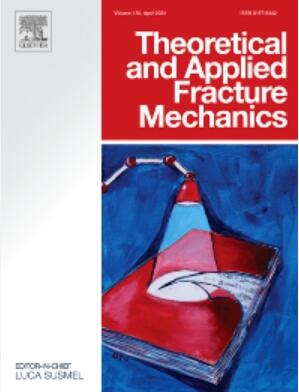Experimental study of fatigue damage and fracture behavior of hot dry rock under thermal shock of seawater
IF 5
2区 工程技术
Q1 ENGINEERING, MECHANICAL
引用次数: 0
Abstract
Global energy transformation has intensified research interest in Enhanced Geothermal Systems (EGS) as a sustainable energy solution. This investigation examines the evolution of fracture characteristics in hot dry rock (HDR) under seawater thermal shock, with particular emphasis on the coupling effects of temperature gradients (100-500°C) and diverse cooling media (air, freshwater, seawater). The experimental methodology incorporated notched deep beam (NDB) configuration for three-point bending tests integrated with Digital Image Correlation (DIC) technology to quantitatively characterize the thermo-chemo-mechanical coupling mechanisms. Statistical analyses demonstrated significant correlations between cooling media and mechanical property degradation (R2 > 0.82, p < 0.05 across all conditions). Seawater exposure induced the most pronounced deterioration, manifested through maximum peak load reduction (83.50 %), highest fracture toughness variance (σ2 = 90.64), and largest fracture energy fluctuation amplitude (24.16 N/m), substantially exceeding the corresponding parameters observed in freshwater (64.96 %, σ2 = 33.17, 13.18 N/m) and air cooling (43.34 %, σ2 = 11.69, 8.22 N/m). Quantitative analysis revealed three characteristic stages of crack propagation and identified a critical temperature threshold at 300°C, marking significant transitions in mechanical behavior. The elevated crack driving parameter (CDP) in seawater-treated specimens (2.5) compared to freshwater conditions (1.5) indicates that seawater-induced chemical corrosion synergistically enhanced thermal shock effects, accelerating microcrack evolution. These findings establish a theoretical framework for optimizing fracture network development in coastal geothermal reservoir stimulation.
全球能源转型加剧了对作为可持续能源解决方案的强化地热系统(EGS)的研究兴趣。本研究探讨了在海水热冲击下干热岩石(HDR)断裂特征的演变,特别强调了温度梯度(100-500°C)和不同冷却介质(空气、淡水、海水)的耦合效应。实验方法采用缺口深梁(NDB)配置进行三点弯曲试验,并结合数字图像相关(DIC)技术,以定量描述热-热-机械耦合机制。统计分析表明,冷却介质与机械性能退化之间存在显著相关性(所有条件下的 R2 均为 0.82,p 均为 0.05)。海水暴露引起的劣化最为明显,表现为最大峰值载荷降低(83.50%)、最高断裂韧性方差(σ2 = 90.64)和最大断裂能量波动幅度(24.16 N/m),大大超过在淡水(64.96%,σ2 = 33.17,13.18 N/m)和空气冷却(43.34%,σ2 = 11.69,8.22 N/m)中观察到的相应参数。定量分析显示了裂纹扩展的三个特征阶段,并确定了 300°C 的临界温度阈值,标志着机械行为的显著转变。与淡水条件(1.5)相比,海水处理试样的裂纹驱动参数(CDP)升高(2.5),这表明海水诱导的化学腐蚀协同增强了热冲击效应,加速了微裂纹的演化。这些发现为优化沿海地热储层激发过程中的裂缝网络发展建立了一个理论框架。
本文章由计算机程序翻译,如有差异,请以英文原文为准。
求助全文
约1分钟内获得全文
求助全文
来源期刊

Theoretical and Applied Fracture Mechanics
工程技术-工程:机械
CiteScore
8.40
自引率
18.90%
发文量
435
审稿时长
37 days
期刊介绍:
Theoretical and Applied Fracture Mechanics'' aims & scopes have been re-designed to cover both the theoretical, applied, and numerical aspects associated with those cracking related phenomena taking place, at a micro-, meso-, and macroscopic level, in materials/components/structures of any kind.
The journal aims to cover the cracking/mechanical behaviour of materials/components/structures in those situations involving both time-independent and time-dependent system of external forces/moments (such as, for instance, quasi-static, impulsive, impact, blasting, creep, contact, and fatigue loading). Since, under the above circumstances, the mechanical behaviour of cracked materials/components/structures is also affected by the environmental conditions, the journal would consider also those theoretical/experimental research works investigating the effect of external variables such as, for instance, the effect of corrosive environments as well as of high/low-temperature.
 求助内容:
求助内容: 应助结果提醒方式:
应助结果提醒方式:


